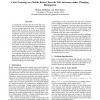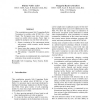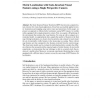128
Voted
IJCAI
2007
15 years 2 months ago
2007
A central goal of robotics and AI is to be able to deploy an agent to act autonomously in the real world over an extended period of time. It is commonly asserted that in order to ...
154
Voted
EUSFLAT
2007
15 years 2 months ago
2007
This contribution presents Soft Computing Robot Navigation for mobile robot SCORCAS, a Case Study. The Navigation uses fuzzy logic experienced on mobile robot systems. Fuzzy logic...
111
click to vote
CIARP
2006
Springer
15 years 2 months ago
2006
Springer
In this work we consider a mobile robot with a laser range finder. Our goal is to find the best set of lines from the sequence of points given by a laser scan. We propose a probabi...
92
Voted
FOCS
1991
IEEE
15 years 4 months ago
1991
IEEE
A polygon with two distinguished vertices, s and g, is called a street iff the two boundary chains from s to g are mutually weakly visible. For a mobile robot with on-board vision...
113
Voted
ROBOCUP
2000
Springer
15 years 4 months ago
2000
Springer
Self localization seems necessary for mobile robot navigation. The conventional method such as geometric reconstruction from landmark observations is generally time-consuming and ...
111
Voted
GECCO
2000
Springer
15 years 4 months ago
2000
Springer
This paper describes an evolutionary way to acquire behaviors of a mobile robot for recognizing environments. We have proposed AEM (Action-based Environment Modeling) approach for...
131
click to vote
EUROS
2006
15 years 4 months ago
2006
Abstract. The Scale Invariant Feature Transform (SIFT) has become a popular feature extractor for vision-based applications. It has been successfully applied to metric localization...
186
Voted
AUSAI
2006
Springer
15 years 4 months ago
2006
Springer
This paper introduces Fuzzy Neural Network controller to increase the ability of a mobile robot in reacting to the dynamic environments. States of robot and environment, for exampl...
150
click to vote
CEC
2007
IEEE
15 years 4 months ago
2007
IEEE
For a mobile robot to move in a known environment and operate successfully, first it needs to robustly determine its initial position and orientation relative to the map, and then ...
216
Voted
AMS
2007
Springer
15 years 4 months ago
2007
Springer
Navigation and application functionality of mobile robots rely on their collision-avoiding capabilities, also known as local navigation. We present the mobile robot ARTOS (Autonomo...



